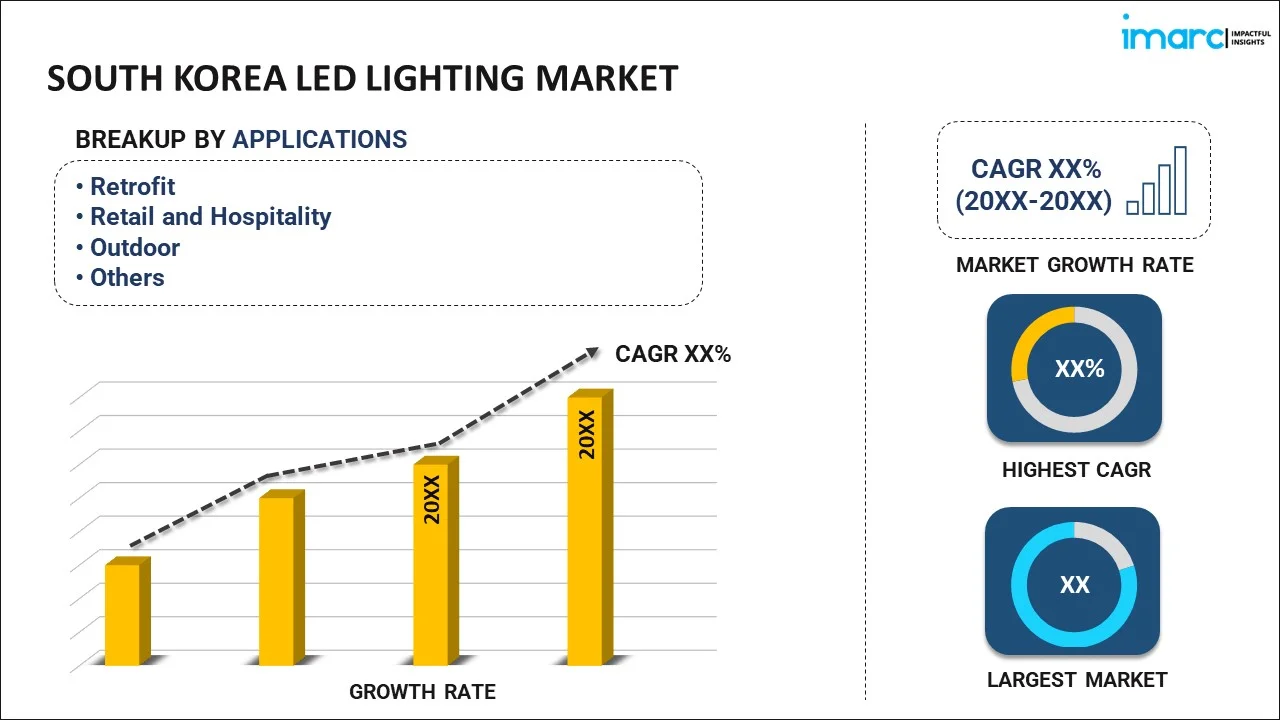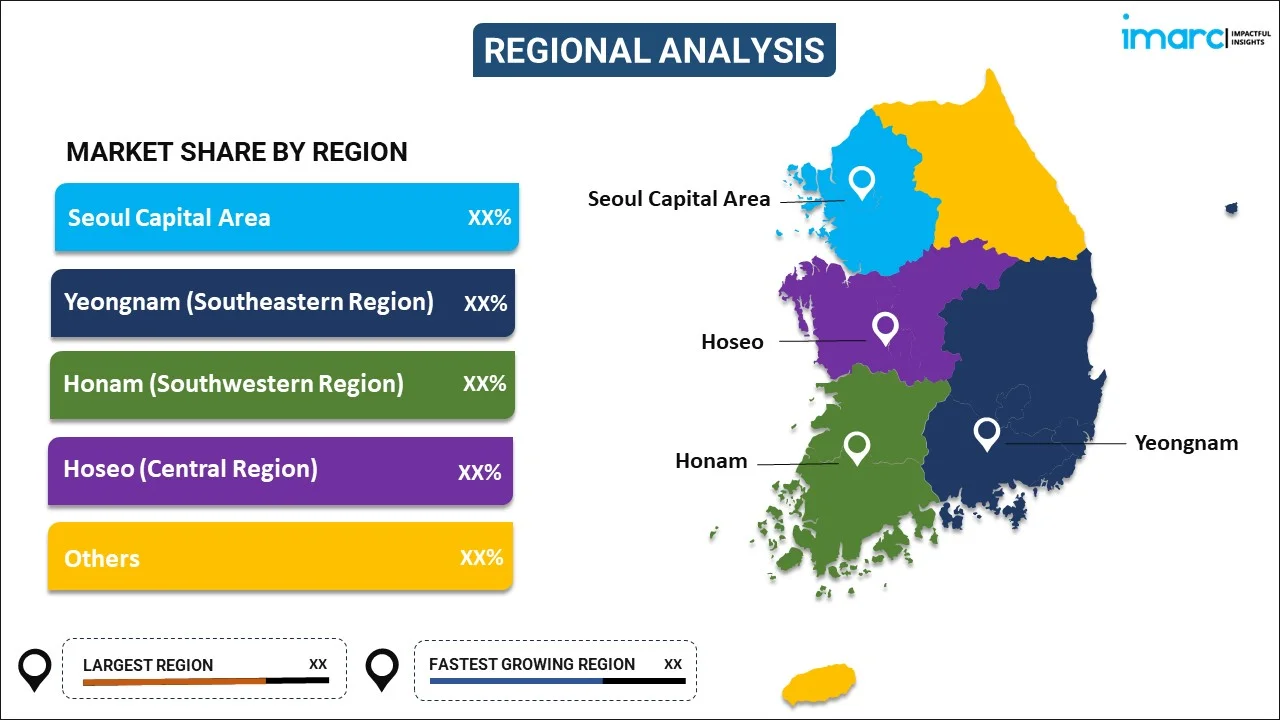
South Korea LED Lighting Market Report by Application (Retrofit, Retail and Hospitality, Outdoor, Offices, Architectural, Homes, Industrial), and Region 2025-2033
Market Overview:
South Korea LED lighting market size reached USD 1,721.0 Million in 2024. Looking forward, IMARC Group expects the market to reach USD 3,299.5 Million by 2033, exhibiting a growth rate (CAGR) of 7.5% during 2025-2033. The increasing emphasis on energy efficiency and sustainability, the rising number of infrastructure development activities, and rapid technological advancements in LED lighting, such as smart lighting systems integrated with IoT technology, and inflating disposable income of individuals represent some of the key factors driving the market.
|
Report Attribute
|
Key Statistics
|
|---|---|
|
Base Year
|
2024 |
|
Forecast Years
|
2025-2033
|
|
Historical Years
|
2019-2024
|
| Market Size in 2024 | USD 1,721.0 Million |
| Market Forecast in 2033 | USD 3,299.5 Million |
| Market Growth Rate (2025-2033) | 7.5% |
LED lighting, an acronym for Light Emitting Diode lighting, is a revolutionary technology in the realm of illumination. It is distinguished by its use of diodes to produce light when an electrical current passes through them. This contrasts sharply with traditional incandescent or fluorescent lighting, which relies on a filament or gas, respectively. The versatility of LED technology has spawned a plethora of types, including standard LED bulbs, panels, tubes, and strip lights, each catering to specific lighting needs and preferences. LEDs consume significantly less power compared to conventional lighting solutions, leading to marked reductions in electricity costs and carbon footprints. Additionally, they boast a remarkably longer lifespan, often lasting tens of thousands of hours, which significantly reduces maintenance and replacement needs. The quality of light produced by LEDs is also a key advantage; they offer a wide range of color temperatures and possess excellent color rendering capabilities, enhancing the visual appeal and functionality of spaces. Their compact size and durability make them suitable for a wide array of applications, from household lighting to commercial and industrial uses.
South Korea LED Lighting Market Trends:
The market in South Korea is primarily driven by the country's strong emphasis on energy efficiency and sustainability and governmental policies and initiatives aimed at reducing carbon emissions. This inclination towards eco-friendly practices is increasing the adoption of energy-efficient lighting solutions. Along with this, the rapid technological advancements in LED lighting, such as smart lighting systems integrated with IoT technology, are favoring the market. In addition, the construction growth in South Korea, marked by the development of residential, commercial, and industrial infrastructures, is also propelling the market. Moreover, the South Korean government's support in terms of subsidies and incentives for LED lighting adoption in public infrastructure is fueling the market. Apart from this, the aesthetic appeal and versatility of LED lighting are leading to its increased application in various sectors, including automotive, electronics, and entertainment, contributing to the market expansion. In confluence with this, with the trend of smart cities and connected systems in South Korea, LEDs are integral to these advanced urban setups, offering enhanced functionality and efficiency. This, in turn, is acting as another catalyst in the growth of the market. Furthermore, the rising consumer awareness regarding the long-term cost savings and environmental benefits of LED lighting is creating a positive market outlook. Some of the other factors driving the market include rapid urbanization and inflating disposable income levels of individuals.
South Korea LED Lighting Market Segmentation:
IMARC Group provides an analysis of the key trends in each segment of the market, along with forecasts at the country level for 2025-2033. Our report has categorized the market based on application.
Application Insights:

- Retrofit
- Retail and Hospitality
- Outdoor
- Offices
- Architectural
- Homes
- Industrial
The report has provided a detailed breakup and analysis of the market based on the application. This includes retrofit, retail and hospitality, outdoor, offices, architectural, homes, and industrial.
Regional Insights:

- Seoul Capital Area
- Yeongnam (Southeastern Region)
- Honam (Southwestern Region)
- Hoseo (Central Region)
- Others
The report has also provided a comprehensive analysis of all the major regional markets, which include Seoul Capital Area, Yeongnam (Southeastern Region), Honam (Southwestern Region), Hoseo (Central Region), and others.
Competitive Landscape:
The market research report has also provided a comprehensive analysis of the competitive landscape in the market. Competitive analysis such as market structure, key player positioning, top winning strategies, competitive dashboard, and company evaluation quadrant has been covered in the report. Also, detailed profiles of all major companies have been provided.
South Korea LED Lighting Market Report Coverage:
| Report Features | Details |
|---|---|
| Base Year of the Analysis | 2024 |
| Historical Period | 2019-2024 |
| Forecast Period | 2025-2033 |
| Units | Million USD |
| Scope of the Report | Exploration of Historical Trends and Market Outlook, Industry Catalysts and Challenges, Segment-Wise Historical and Future Market Assessment:
|
| Applications Covered | Retrofit, Retail and Hospitality, Outdoor, Offices, Architectural, Homes, Industrial |
| Regions Covered | Seoul Capital Area, Yeongnam (Southeastern Region), Honam (Southwestern Region), Hoseo (Central Region), Others |
| Customization Scope | 10% Free Customization |
| Post-Sale Analyst Support | 10-12 Weeks |
| Delivery Format | PDF and Excel through Email (We can also provide the editable version of the report in PPT/Word format on special request) |
Key Questions Answered in This Report:
- How has the South Korea LED lighting market performed so far and how will it perform in the coming years?
- What is the breakup of the South Korea LED lighting market on the basis of application?
- What are the various stages in the value chain of the South Korea LED lighting market?
- What are the key driving factors and challenges in the South Korea LED lighting?
- What is the structure of the South Korea LED lighting market and who are the key players?
- What is the degree of competition in the South Korea LED lighting market?
Key Benefits for Stakeholders:
- IMARC’s industry report offers a comprehensive quantitative analysis of various market segments, historical and current market trends, market forecasts, and dynamics of the South Korea LED lighting market from 2019-2033.
- The research report provides the latest information on the market drivers, challenges, and opportunities in the South Korea LED lighting market.
- Porter's five forces analysis assist stakeholders in assessing the impact of new entrants, competitive rivalry, supplier power, buyer power, and the threat of substitution. It helps stakeholders to analyze the level of competition within the South Korea LED lighting industry and its attractiveness.
- Competitive landscape allows stakeholders to understand their competitive environment and provides an insight into the current positions of key players in the market.
Need more help?
- Speak to our experienced analysts for insights on the current market scenarios.
- Include additional segments and countries to customize the report as per your requirement.
- Gain an unparalleled competitive advantage in your domain by understanding how to utilize the report and positively impacting your operations and revenue.
- For further assistance, please connect with our analysts.
 Request Customization
Request Customization
 Speak to an Analyst
Speak to an Analyst
 Request Brochure
Request Brochure
 Inquire Before Buying
Inquire Before Buying




.webp)




.webp)












